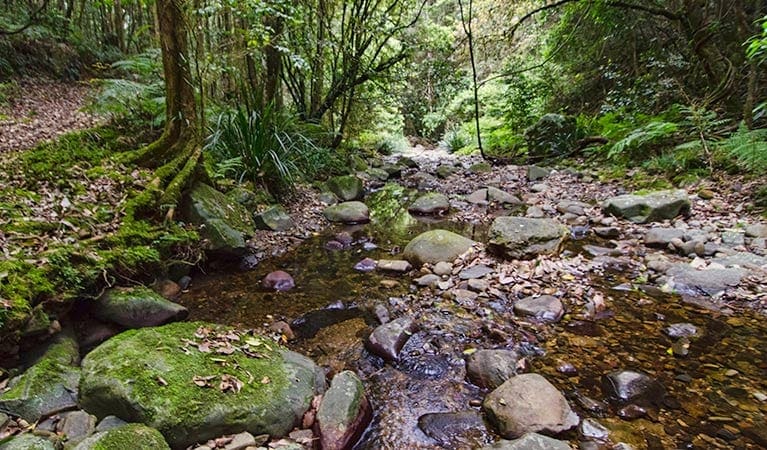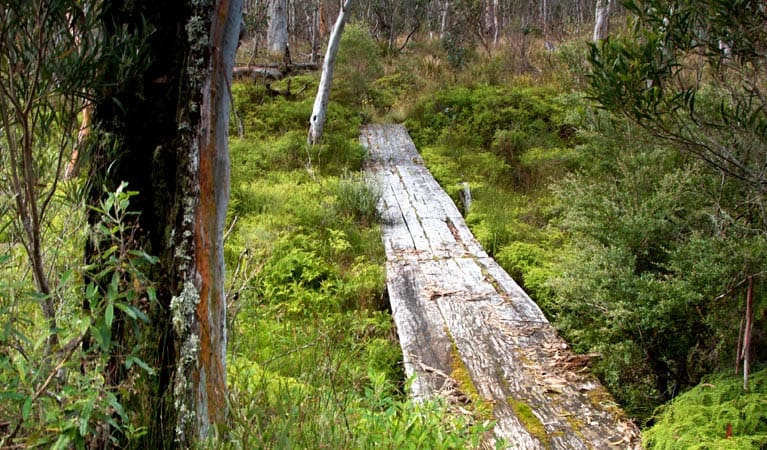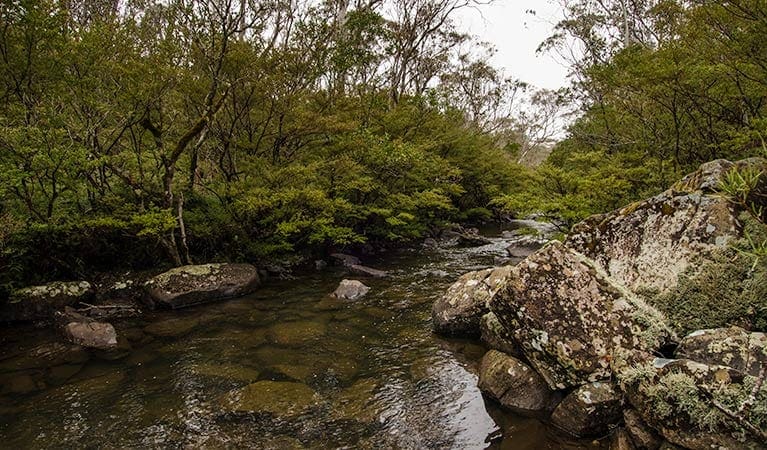Hike at a Glance
Max elevation: 1249m
Min elevation: 771m
Total Ascent: 1053m
Hike overview
The challenging Mountaineer-Glowang trail in Barrington Tops National Park is a rewarding one-way hike offering breathtaking scenery across the wilderness of Gloucester Tops. This 15-kilometer, grade 4 track, suitable for experienced hikers, takes approximately 7 hours to complete and starts near Wangat Road.
Calling all outdoor enthusiasts seeking a challenging adventure! The Mountaineer-Glowang trail showcases the best of southern Barrington Tops National Park. Traverse a diverse landscape as you follow a ridgeline, climbing several peaks, including The Mountaineer, each offering inspiring views across the vast wilderness. The vegetation transforms dramatically with altitude, transitioning from blue gum and messmate forests to Antarctic beech at higher points.
Joining the Glowang Trail, you'll encounter rainforests teeming with coachwood and sassafras before a steeper climb rewards you with yet more spectacular views, now overlooking the deep Gloucester River gorge. Finally, Mount Nelson marks a descent into open woodlands before reaching the Gloucester Tops picnic area - a welcome sight for weary legs.
Tips
- Apply sunscreen liberally before you set out and wear a hat for protection throughout the day.
- Limited or no drinking water is available along the ridgeline. Ensure you carry enough water for the entire duration of your hike.
- The access road to the Mountaineer-Glowang trail can become boggy after rainfall. Always check the weather forecast before you go to avoid getting stuck.
- For safe navigation, consider bringing a topographic map, compass, and a GPS device, particularly if you're unfamiliar with the area.
Gallery
Got some great shots from this hike? Upload your photos here to inspire others and show off the beauty of the trail!
Click to view form >>
Submitting your photos doesn’t mean you lose ownership. You can be credited for your contributions, and you can request removal at any time.
Content use
Please don’t copy GPX files or content from this site to AllTrails or other platforms. Each trail has been personally mapped, documented, and refined to support Australia’s bushwalking and hiking community. While some details come from land managers, every listing reflects significant personal effort. This is a free, community-driven initiative—your respect helps keep it that way.
Walk map and GPX file
Max elevation: 1249 m
Min elevation: 771 m
Total climbing: 1053 m
Total descent: -819 m
Getting there
Getting to the trailhead: Barrington Tops National Park.
Accessing the Mountaineer-Glowang trail requires choosing your starting point. If you’re coming from the south, the trailhead begins near Wangat Road in Chichester State Forest, bordering Barrington Tops National Park’s southeastern edge. To get here, travel north on Chichester Dam Road from Dungog for roughly 20 kilometers. Then, turn right onto Wangat Road and follow it until the very end, a further 20 kilometers or so.
Alternatively, if you’re approaching from Gloucester Tops picnic area, take Bucketts Way between Gloucester and Stroud. Turn onto Gloucester Tops Road and continue until you reach the Gloucester River. After passing the river, continue for approximately 40 minutes before taking the left fork leading to Gloucester Tops picnic area. Parking is available at both starting points, allowing you to choose the route that best suits your travel plans.
Closest towns to this walk: Dungog, Ebor, Gloucester, Merriwa, Moonan Brook, Moonan Flat, Murrurundi, Muswellbrook, Nabiac, Scone, Singleton, Stroud, Wingen, Wingham
About the region
The Barrington Tops National Park offers a diverse range of experiences for every visitor. Immerse yourself in the World Heritage-listed Gondwana Rainforests, teeming with ancient walking trails, cascading waterfalls, and breathtaking lookouts. Explore the park's extensive network of walking tracks, catering to all levels, from gentle strolls to challenging overnight hikes. Scenic picnic areas and cycling trails provide perfect options for day trips.
Carved by ancient volcanic flows, the park boasts one of mainland Australia's largest temperate rainforests. Rising from near sea level to over 1,500 metres, it encompasses diverse habitats teeming with birdlife and animals. Camping enthusiasts can find designated spots for an unforgettable evening under the stars.
For those seeking adventure, options abound. Kayak across serene waters, challenge yourself with abseiling, or explore the terrain on a mountain bike. At the foothills, Chichester State Forest offers stunning scenery along the Allyn River, with campsites even welcoming your canine companions.
Beyond the park, discover the charming towns of Dungog and Gloucester. Gloucester, nicknamed the "basecamp for Barrington Tops," provides a welcoming gateway to your Gondwana adventures. Enjoy a refreshing dip in Ladies Well on a hot day, or venture further for hiking and picnicking opportunities in nearby Mount Royal National Park. Trout fishing enthusiasts can cast their lines in the Gloucester River between October and June.
Barrington Tops National Park, a magnificent region near the Hunter Valley and Upper Hunter, is easily accessible. Just a few hours' drive north of Sydney or a short trip from Newcastle and Port Stephens, this World Heritage wonder awaits exploration.
Similar walks nearby
Looking for more walks in or near Barrington Tops National Park? Try these trails with a similar difficulty grade.
Track grade
Grade 4 (Hard) - Challenging Walks for Experienced Walkers: Grade 4 on the AWTGS signifies challenging walking tracks. Bushwalking experience is recommended for these tracks, which may be long, rough, and very steep. Directional signage may be limited, requiring a good sense of navigation. These walks are suited for experienced walkers who are comfortable with steeper inclines, rougher terrain, and potentially longer distances.
Explore safe
Plan ahead and hike safely! Carry enough water, pack layers for changing conditions, and bring safety gear like a torch, PLB, and reliable communication device. Check official sources for trail updates, closures, and access requirements, and review local weather and bushfire advice. Most importantly, share your plans with someone before you go. Being prepared makes for a safer and more enjoyable hike! Stay Safe, Explore More, and Always #ExploreSafe.
Packing checklists
What you carry in your pack depends on factors like weather, terrain, and your adventure type. Not sure what to bring? My free planning, food, and packing checklists are a great starting point, covering day hikes, overnight trips, and multi-day adventures. Use them to customise your kit and always prioritise safety.
Let someone know
Before heading out, take a moment to fill out your trip intentions form. It’s a quick way to share your hike details with family or friends. If something goes wrong, they can notify emergency services, ensuring a faster response and peace of mind. Stay safe and enjoy your adventure
Suggest an edit
Spotted a change on this trail? Maybe there are new features, the route has shifted, or the trail is permanently closed. Whatever the update, I’d love your input. Your feedback helps fellow hikers stay informed and ensures that our trail info stays fresh and reliable.
Acknowledgement of Country
Trail Hiking Australia acknowledges the Traditional Owners of the lands on which we hike and pay respects to their Elders, past and present, and we acknowledge the First Nations people of other communities who may be here today.






